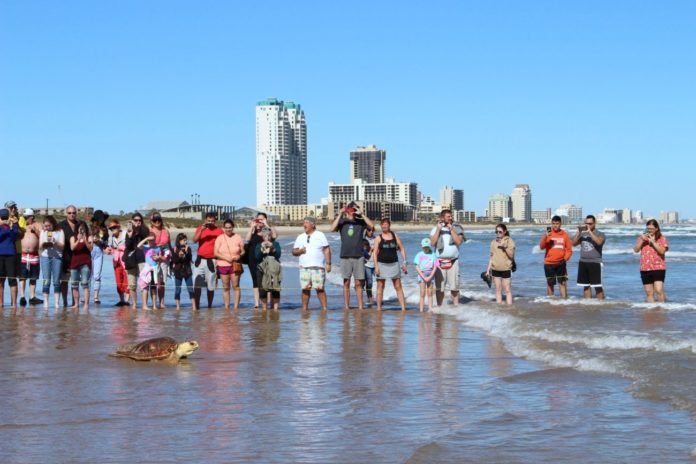State and local authorities are still waiting to see whether cold temperatures will result in a fish kill on South Padre Island.
On a frigid cloudy Tuesday, temperatures were in the 40s, but strong winds made the Island feel much colder. There was a constant drizzle.
As of Tuesday afternoon, Cameron County Parks Director Joe Vega and the Texas Parks and Wildlife Department said they hadn’t found any fish kills yet. Misty Porte, a marketing assistant with Sea Turtle Inc., said patrols looking for cold-stunned turtles in the area had not noted any fish kills, either.
“I just got back from a patrol with another staff member,” Porte said Tuesday morning. “We didn’t notice any of that but the tide is pretty far out so maybe when the tide comes in (the fish) will get pushed in.”
Sea Turtle Inc. is preparing for another round of cold-stunned turtles because of the chilly temperatures. The nonprofit agency was to be closed today as it prepares for an influx of endangered sea turtles.
Julie Hagen, a social media specialist with the Coastal Fisheries Division of TPWD, said it’s not surprising that South Padre Island hasn’t seen evidence of a fish kill yet.
“With this type of freeze event we are not expecting fish kills to surface for a few more days when the temperature increases and the dead fish surface,” Hagen said in an email.
On Monday, TPWD announced that fishing bans would be in effect because of the freezing temperatures. There are two bans in place in Cameron County.
No fishing is allowed in the area from the shore out to a line from the middle of the Queen Isabella Memorial Causeway on the northwest and the end of the old causeway on the southeast, including the Gulf Intracoastal Waterway bounded by the Queen Isabella Memorial Causeway on the north and the Port Isabel Swing Bridge on the south. The adjacent canal in Port Isabel is not included in the ban.
The second area is in the Gulf of Mexico from, and including, the Brazos Santiago Pass south jetty along the beach for one half mile and out from shore for 1,000 yards.
The entire harbor in Willacy County from the bulkheads on either side of the harbor to the harbor mouth is also included in the ban, which lifts at 10 p.m. today.
“The length of a closure is based on the expected temperatures over a three- to four-day period,” Hagan said. “The more prolonged the freeze the longer the close can become. Temperatures are expected to rise beginning mid-day Thursday, Jan. 4; therefore we are lifting the ban the night before.”
The closures protect the fish, Hagan explained.
“These closures were made to protect surviving fish that are vulnerable to capture during the freeze event,” Hagan said. “Hard freezes cause surviving fish to congregate in deeper water and become sluggish – thus becoming more prone to capture by anglers because of their close proximity and lethargic nature induced by the cold temperatures.”
According to TPWD, there are two million acres of bays and estuaries susceptible to freeze in the Lone Star State.
In the 1980s, there were three major freezes, including a 1989 freeze where temperatures dropped to 16 degrees, killing an estimated 11 million fish near Brownsville, according to TPWD.
Late Tuesday morning and early afternoon, no dead fish were observed at the Jaime Zapata Memorial Boat Ramp; or on the north side of Highway 48 by the Carl “Joe” Gayman Channel; at the South Padre Island public bay access; or on the beach near Isla Grande Beach Resort; or off the boardwalk at the South Padre Island Birding and Nature Center, which is on the bay.
Javier Gonzalez, a naturalist and educator at the SPI Birding and Nature Center, said that in early December dead fish washed up in the area after cold weather. That same bout of cold resulted in numerous cold-stunned turtles being rescued, 60 of which were released about a week later into the Gulf of Mexico.
“If there’s one this week it gets real active,” Gonzalez said, explaining that birds and other wildlife take advantage of a fish kill to regain calories lost during cold snaps.
“The pelicans especially come and gorge,” Gonzalez said. “Even birds that don’t eat fish eat to get calories.”
Other scavengers, like crabs and sea gulls, also arrive to feast, Gonzalez explained.
“Everybody’s hungry,” Gonzalez said of wildlife surviving the few cold stretches that descend on the Rio Grande Valley each year.
But there weren’t any dead fish yet, despite bitter wind blowing over the boardwalk.
The hundreds of ducks at the end of the boardwalk almost seemed to be enjoying the frigid air while floating in low tide, possibly waiting for an easy meal.
When asked what a fish kill is like, Gonzalez aptly replied: “It gets pretty fishy.”
TPWD is asking any anglers or coastal residents to report any freeze-related fish kills or large numbers of sluggish or cold-stunned fish by contacting the department’s Law Enforcement Communications office at (281) 842-8100 or (512) 389-4848.

mreagan@brownsvilleherald.com




